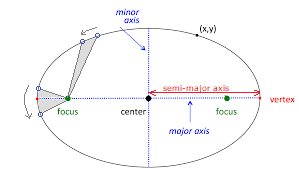- EARTH'S ORBIT:
Earth's orbit around the Sun is approximately circular.
Nicolaus Copernicus was the first scientist to explain that the Earth revolved around the Sun. He thought the orbit was a circle.
- Kepler's laws:
Johannes Kepler made very careful measurements of the Sun's position in the sky and the position of the moon and stars.
Around 1619, he concluded that Earth's orbit was not exactly circular, but followed three laws:
- 1. Earth's orbit is shaped like an ellipse, with the Sun at one focus. (The ellipse is almost circular.)
- 2. A line connecting the Earth and Sun sweeps out an equal area each day, or in each of several equal time intervals.
- 3. The square of a planet's orbital time period is proportional to the cube of the size ("semi-major axis") of its orbit.
(The "major axis" of an ellipse is its longest diameter; the "semi-major axis" is half of this.)
We now know that all planets (and satellites) have orbits that follow Kepler's laws.
Kepler's laws helped Isaac Newton figure out his law of gravitational attraction.
He was able to explain Kepler's laws
as the result of a balance between gravitational attraction and centrifugal force.

For any point (x,y) on the ellipse, L1 + L2 = L
(where L is the length of the major axis)
The focal distance (d) is the distance between the two foci
The eccentricity is equal to d / L or
__ focal distance ____
 length of major axis length of major axis
Kepler's second law: Any planet moves faster through its orbit when it is closer to the Sun.
If the gray arrows represent equal time intervals,
then the (nearly triangular) gray areas are equal.

CLICK HERE for a more detailed explanation, with animations.
Kepler's third law: The square of a planet's orbital period is proportional to the cube of the size of its semi-major axis.
| Planet | Orbital time period (P) (years)
| Semi-major axis (S) (Astronomical Units = A.U.)
| P2 | S3
| | Mercury | 0.24084 | 0.387 | 0.0580 | 0.0580
| | Venus | 0.61518 | 0.723 | 0.3784 | 0.3779
| | Earth | 1.00000 | 1.000 | 1.0000 | 1.0000
| | Mars | 1.88082 | 1.524 | 3.5375 | 3.5396
| | Jupiter | 11.862 | 5.203 | 140.71 | 140.85
| | Saturn | 29.457 | 9.537 | 867.72 | 867.43
| | Uranus | 84.011 | 19.191 | 7057.8 | 7067.9
| | Neptune | 164.79 | 30.069 | 27156. | 27187.
|
|